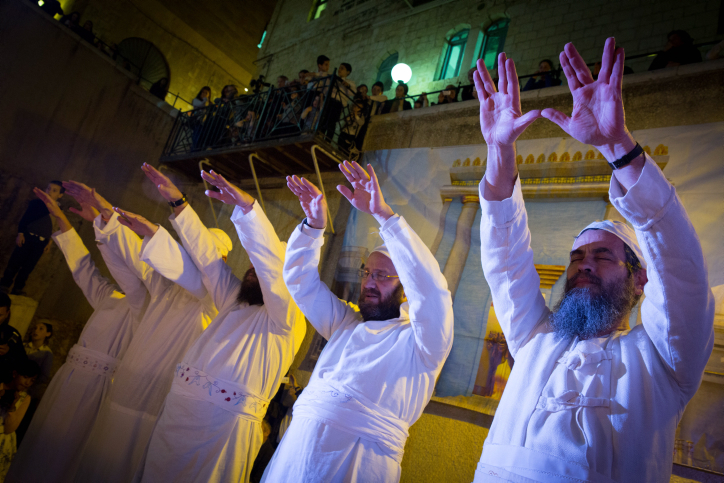The Jewish Temple Movement has for years tried to change the status quo in one of the most contested holy sites in the world. Now the most mainstream figures on the Israeli right are finally listening.
By Yonathan Mizrachi

The Hebrew and Muslim calendars have, at times, had an effect on the political conflict surrounding the contested Temple Mount/Haram al-Sharif in Jerusalem. Both calendars are based on a lunar cycle of 354 days, although the Hebrew calendar adds an additional month every four years, so as to match the sun cycle.
The fact that there is no alignment between the two calendars has, over the last year, led to a number of complex political challenges. The first one took place in the beginning of June when Jerusalem Day — the national holiday in which tens of thousands of Jewish Israelis march through the Old City to mark the re-unification of the city, often provoking the Palestinians there — coincided with the end of Ramadan.
Temple Mount activists, who seek to upend the decades-long status quo and worship freely at the site, took advantage of the coinciding days to pressure the government to allow them to enter the Temple Mount. The government acceded, leading to confrontations and violence with Muslim worshippers there. Israeli politicians didn’t seem to mind.
The fact that this year Tisha B’Av coincided with the first day of the Muslim holiday of Eid al-Adha had far greater consequences. For religious Jews, Tisha B’Av marks the day Jews mourn the destruction of their Temple, and is considered one of the most religiously important days of the year — especially for those who seek to worship at the Temple Mount. The fact that it fell on the same day as Eid al-Adha, which commemorates the Muslim prophet Ibrahim’s test of faith, was potentially explosive. Until Sunday, there had never been any non-Muslim presence on Haram al-Sharif during Eid al-Adha. That is why maintaining the status quo on the first day of the holiday has been especially important for Muslim worshippers.
That Israeli elections are just around the corner also gave the Temple movement a boost on Tisha B’Av. The Israeli media’s focus on the entry of Jewish worshippers to the Temple Mount led to a war of words between Prime Minister Benjamin Netanyahu and Transportation Minister Bezalel Smotrich, who accused the prime minister of “weakness” and showing “zero leadership” for initially barring Jews from entering the compound on Tisha B’Av. The pressure from the far-right worked, and the police eventually allowed the worshippers to enter the site. In the eyes of the prime minister, preventing their entry would have played directly into the hands of the far-right Yamina party, whose voters he is trying to court.
The responses by Israeli politicians to the events at the Temple Mount/Haram al-Sharif this week reveal that the Temple Movement has succeeded in both getting the attention of the media as well as receiving newfound support from the right. Smotrich’s backing, of course, is nothing new; in 2015 he submitted a bill to the Knesset that would allow Jews to pray freely at the Temple Mount. Public Security Minister Gilad Erdan, who reiterated his support for changing the status quo, has also repeatedly backed the movement.

The movement’s newest supporter is Ayelet Shaked, who ostensibly supports all the right’s goals but has yet to officially endorse a change in the status quo on the Temple Mount/Haram al-Sharif. On the contrary: back in 2015, Shaked even said Israel should refrain from allowing Jews to worship at the Mount. Currently in the throes of a fateful election campaign that will decide her political future, she has decided to court the right-wingers who support the Temple Movement. Like Smotrich, Shaked also criticized Netanyahu, most likely after she understood that it would be politically wise to back the movement. Her support significantly strengthens the complete legitimization of Jewish worship on the Temple Mount among the religious right, which is politically to the right of Likud.
Matters of religion and state will be a central issue in the upcoming elections, and Jewish worship at the Temple Mount aligns perfectly with the right’s aspirations to strengthen religious elements in Israeli society, including in the education system and the legal establishment. The presence of Jewish worshippers entering the Temple Mount/Haram al-Sharif during Eid al-Adha signals not only a change in the status quo between Israel and the Jerusalem Islamic Waqf, the custodian of Haram al-Sharif, but also in the way right-wing voters themselves view the Temple Movement, which just a few years ago was considered fringe, even among the settlers. If the right manages to stay in power after these elections, there is no doubt that the status quo will continue to come undone.
Yonathan Mizrachi is a members of Emek Shaveh, an Israeli NGO that working to protect ancient sites as public assets that belong to members of all communities, faiths and peoples. This article was first published in Hebrew on Local Call. Read it here.

